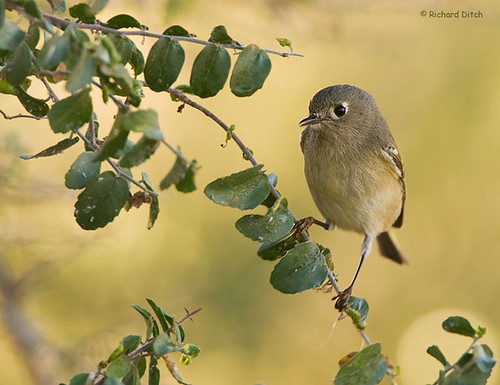tags: Ruby-crowned Kinglet, Regulus calendula, birds, mystery bird, bird ID quiz
[Mystery bird] Ruby-crowned Kinglet, Regulus calendula, photographed in Arizona. [I will identify this bird for you tomorrow]
Image: Richard Ditch, 2006 [larger view].
Please name at least one field mark that supports your identification.
Rick Wright, Managing Director of WINGS Birding Tours Worldwide, writes:
Now comes a tiny bird, barley bigger than the leaves of the desert hackberry it's perched among. The gray plumage, hint of a wingbar, and conspicuous but broken eyering are characteristic of two common birds of the American southwest: Ruby-crowned Kinglet and Hutton's Vireo. An earlier analysis pointed out the obvious differences in wing pattern, but that won't help us here; all we can see is that the median coverts are boldly tipped white, a feature that by itself might make me think of the vireo. The fact that the bill is open makes its depth hard to judge, though the tip of the upper mandible appears fine, not hooked, which makes me think of the kinglet.
A view like this, though it obscures some of the classic field marks that distinguish those two surprisingly similar species, provides the perfect opportunity to deploy a different, lesser-known character. The tarsus of kinglets (like that of thrushes and a few other passerine groups) is "booted," nearly the entire length of the foot covered by a single scale rather than the shingled-roof pattern of most passerines -- including vireos. As a result, the grayish tarsus of Hutton's Vireo appears stout and strong, while the paler tarsus of Ruby-crowned Kinglet seems impossibly slender, vanishingly thin -- just as on the kinglet in our mystery photo.


Ruby-crowned Kinglet. I can't see the base of the primaries to use that to differentiate from the Hutton's Vireo, but having given a good long stare at the beak last time around, I'm definitely thinking this looks more like a delicate kinglet beak than a sturdy, hooked vireo beak. Per Sibley, too, the vireo has "heavy bluish legs", which this bird lacks.
yep, it's an RCKI ...
A little gray bird I recognize - Ruby-crowned Kinglet.
One thing I've learned while taking part in the Mystery Bird, is how much I rely on the birds' behaviors in the field. Looking at a static picture of a bird adds an additional challenge to making the ID. Even though I recognize this bird, I want to see it flicking its wings and hear it scolding me before I know it is what it is.
Ruby-crowned kinglet. The really long skinny legs and the thin bill distinguish this from any warblers or vireos.
The real mystery?
How does one get such a nice photo of this species? They never stop moving!
It looks like a live bird...
A hearty second to Steve Duncan's remarks: identifying photos is massively more difficult than working with real birds, which move and vocalize! But I'm repeatedly impressed at how good at it everyone is who plays along here.
"The real mystery?
How does one get such a nice photo of this species? They never stop moving!
It looks like a live bird..." - kamaka
Yes, it is a live bird, and wild and unbaited as with all my photos.
As notes, Kinglets are very difficult subjects because they are so small and so active. Digital cameras have made it a little easier to get good photos because it doesn't cost $.40 in film and processing every time the shutter is tripped, so photographers can now take a lot more shots to increase the odds of getting the bird still.
It also helps to spend a lot of time out with the birds looking for opportunities to take photos in the first place.